Culinary Rhapsodies: Gyoza
30 Dec 2012
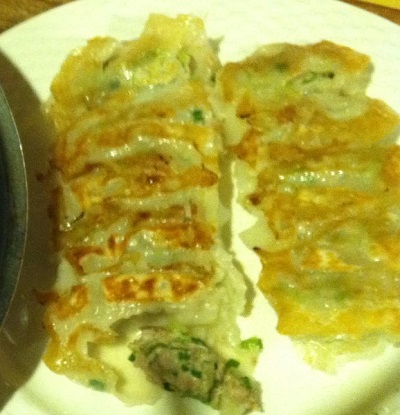
This is our family recipe for gyoza. Each one of us women in the household make it slightly different. Mom likes more cabbage in it while grandma and I like it with more meat. Mom cooks it with a mixture of sesame oil and vegetable oil while I put the sesame oil into the gyoza and use only vegetable oil to cook it. My sister likes it deep fried, I like it crispy pan fried. My husband and I make these and freeze them for nights so we can pull them out for a quick dinner when we don’t have time to cook. They keep in the freezer for a month or two. They usually disappear before that so I’ve never tried them after the second month mark! We ate them for dinner with my parents tonight and we had enough to fill your adult tummies and had half the lot left over to freeze. Each gyoza wrapper pack comes with 50 – 60 wraps.
Ingredients:
• 1 lb of pork
• ¼ Japanese cabbage
• 2 nira (green garlic chives)
• 1 scallion
• ½ – 1 teaspoon ginger juice (directions below on how to do this)
• 3 garlic cloves
• 1 shiitake mushrooms
• ½ tablespoon of soy sauce
• ¼ teaspoon of sesame oil
• 1 packet of gyoza wrappers
• salt and pepper to taste
Directions:
- Dice the cabbage and shiitake. Finely chop the scallion and nira. Place it in a bowl and mix together. (In the photo I have the cabbage and other ingredients separate to show the amount.)
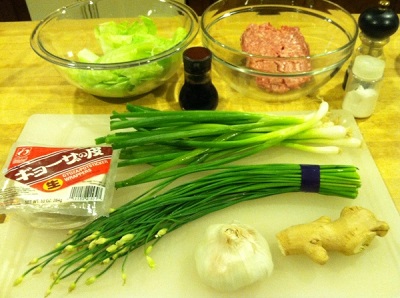
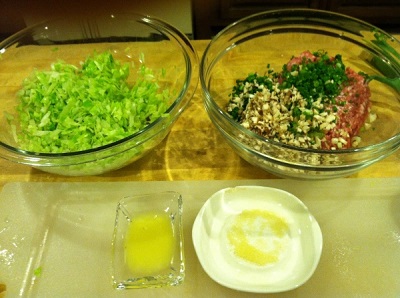
- Take the garlic clove and use an oroshigane or oroshiki (the white grater you see in the photo) to grate the garlic. Place that in the bowl with the other ingredients. With the ginger, take the brown skin off with a pairing knife and grate on the oroshiki. Once you grate the ginger, make a pile of the grated ginger and squeeze between your fingers.photo You will only be using the liquid from the ginger (seen in the small glass container in the photo). I like more ginger in my gyoza so I use about 1 teaspoon. Mom likes less and only a hint so she uses only 1/2 teaspoon. It’s based on your preference.
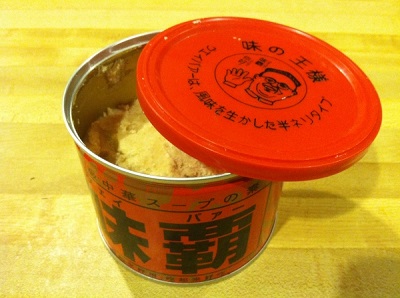
My mom also adds this. I believe the spelling in English would be weipa. It’s close to chicken stock but in a solid form and there’s no need to dilute it with water.
Mix all the ingredients together by hand. Take the mixture and place a teaspoon in the center of the gyoza wrappers. My husband makes them Chinese style while I make them Japanese style. His stand up, mine lay flat. Here’s a video on how to make them. We’ve uploaded both styles in slow motion. We hope it’s clear. (Excuse the yellow counter and the bad quality video including my mom chopping something in the kitchen. We’re at my parents’ place so we have the old school decor in the kitchen and we didn’t have my Flip camera.)
Once the dumplings are wrapped, you can cook them in your preferred style. You can eat them:
a. Boiled: boil water in a pot and place gyoza it in for 3 – 5 minutes or until done. Scoop them out and serve.
b. Deep fried: them (my sister’s preferred method): heat oil in a fryer or a deep sauté pan. If it’s in a deep sauté pan, make sure there’s 2 inches of oil in it. Fry at medium heat until the gyoza is a light brown color.
c. Steamed: you can use a steamer or a shallow sauté pan or even a large frying pan. If you’re using a pan, place about 3 cm of how water and place the gyoza in it. Cover for 5 minutes. If you’re not using a non-stick pan, add a touch of oil in the water so they do not stick to the bottom of the pan.
d. Fried in a frying pan: cover the bottom of the frying pan with oil.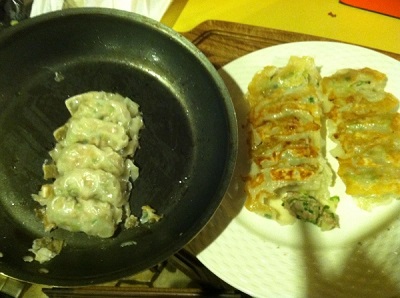 Place the gyoza on it, add a tablespoon of water and cover. Heat until the water has evaporated. Add a bit of oil so the bottom of the pan is coated and cook for an additional 2 minutes or until the meat is cooked and the bottom is crunchy.
Place the gyoza on it, add a tablespoon of water and cover. Heat until the water has evaporated. Add a bit of oil so the bottom of the pan is coated and cook for an additional 2 minutes or until the meat is cooked and the bottom is crunchy.Eat it with soy sauce mixed with vinegar. Everyone else in my family likes adding la-yu (chili oil) into the soy sauce. I like mine without!
Video link is broken and will be updated in the near future (March 2021)